Cyan Enterprises: Financial Statement Audit Report
VerifiedAdded on 2020/05/11
|16
|3090
|107
Report
AI Summary
This report presents a detailed audit of Cyan Enterprises' financial statements. It begins with audit planning, including analytical review using ratios and trends to identify risky areas and unusual transactions. The report then discusses preliminary judgments of materiality, assessing the significance of financial items. Several accounting items, including consultancy fees, bank charges, interest income, sales, depreciation, cost of sales, and superannuation, are analyzed in detail. Each section provides a rationale for selection, identifies relevant assertions (reliability, accuracy, completeness, etc.), and recommends specific audit procedures. The report emphasizes the importance of verifying supporting documents, checking journal entries, and comparing figures to bank statements to ensure accuracy and completeness. The analysis highlights potential misstatements and the need for extended audit procedures based on materiality assessments. References and an appendix with ratio calculations are included to support the findings.

Paraphrase This Document
Need a fresh take? Get an instant paraphrase of this document with our AI Paraphraser
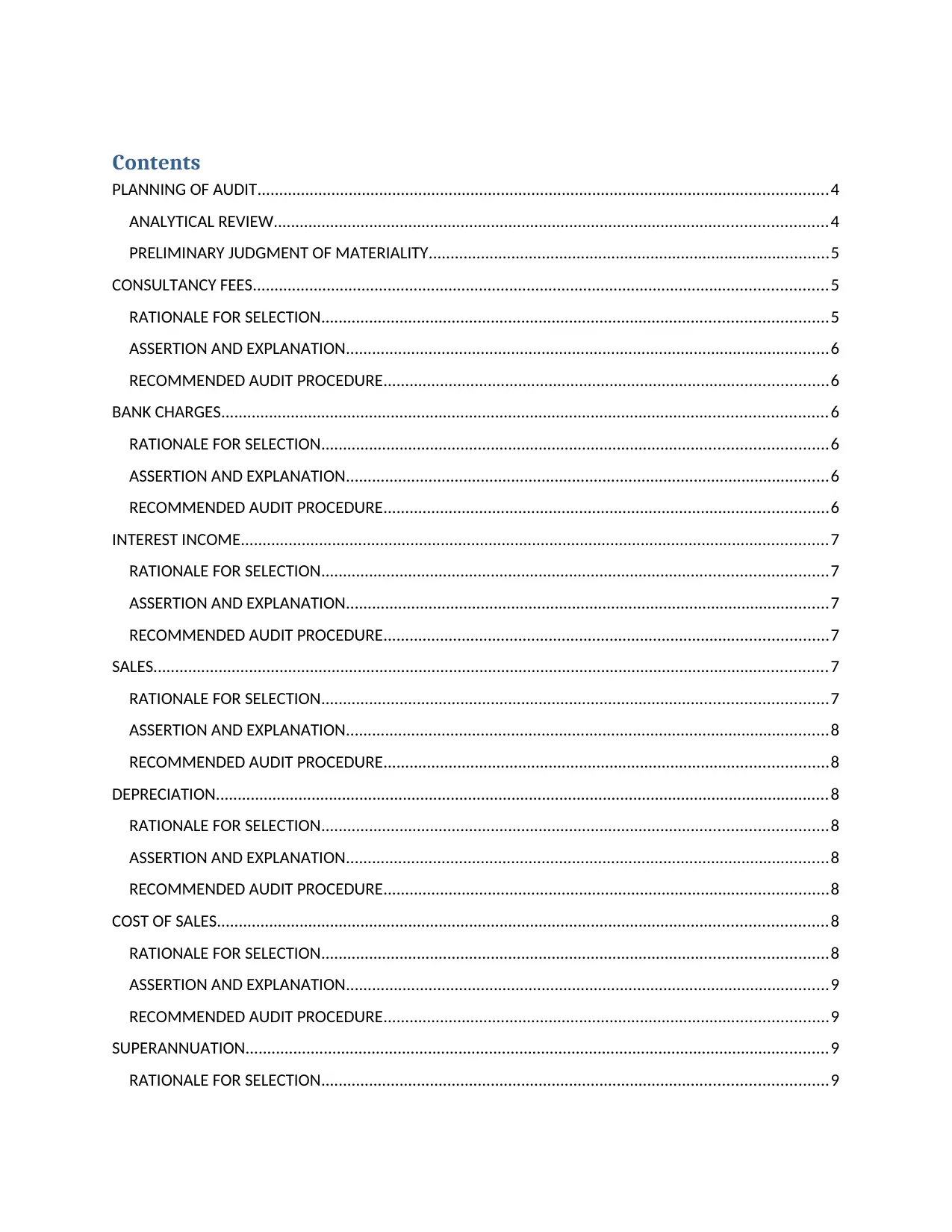
Contents
PLANNING OF AUDIT...................................................................................................................................4
ANALYTICAL REVIEW...............................................................................................................................4
PRELIMINARY JUDGMENT OF MATERIALITY............................................................................................5
CONSULTANCY FEES....................................................................................................................................5
RATIONALE FOR SELECTION....................................................................................................................5
ASSERTION AND EXPLANATION...............................................................................................................6
RECOMMENDED AUDIT PROCEDURE......................................................................................................6
BANK CHARGES...........................................................................................................................................6
RATIONALE FOR SELECTION....................................................................................................................6
ASSERTION AND EXPLANATION...............................................................................................................6
RECOMMENDED AUDIT PROCEDURE......................................................................................................6
INTEREST INCOME.......................................................................................................................................7
RATIONALE FOR SELECTION....................................................................................................................7
ASSERTION AND EXPLANATION...............................................................................................................7
RECOMMENDED AUDIT PROCEDURE......................................................................................................7
SALES...........................................................................................................................................................7
RATIONALE FOR SELECTION....................................................................................................................7
ASSERTION AND EXPLANATION...............................................................................................................8
RECOMMENDED AUDIT PROCEDURE......................................................................................................8
DEPRECIATION.............................................................................................................................................8
RATIONALE FOR SELECTION....................................................................................................................8
ASSERTION AND EXPLANATION...............................................................................................................8
RECOMMENDED AUDIT PROCEDURE......................................................................................................8
COST OF SALES............................................................................................................................................8
RATIONALE FOR SELECTION....................................................................................................................8
ASSERTION AND EXPLANATION...............................................................................................................9
RECOMMENDED AUDIT PROCEDURE......................................................................................................9
SUPERANNUATION......................................................................................................................................9
RATIONALE FOR SELECTION....................................................................................................................9
PLANNING OF AUDIT...................................................................................................................................4
ANALYTICAL REVIEW...............................................................................................................................4
PRELIMINARY JUDGMENT OF MATERIALITY............................................................................................5
CONSULTANCY FEES....................................................................................................................................5
RATIONALE FOR SELECTION....................................................................................................................5
ASSERTION AND EXPLANATION...............................................................................................................6
RECOMMENDED AUDIT PROCEDURE......................................................................................................6
BANK CHARGES...........................................................................................................................................6
RATIONALE FOR SELECTION....................................................................................................................6
ASSERTION AND EXPLANATION...............................................................................................................6
RECOMMENDED AUDIT PROCEDURE......................................................................................................6
INTEREST INCOME.......................................................................................................................................7
RATIONALE FOR SELECTION....................................................................................................................7
ASSERTION AND EXPLANATION...............................................................................................................7
RECOMMENDED AUDIT PROCEDURE......................................................................................................7
SALES...........................................................................................................................................................7
RATIONALE FOR SELECTION....................................................................................................................7
ASSERTION AND EXPLANATION...............................................................................................................8
RECOMMENDED AUDIT PROCEDURE......................................................................................................8
DEPRECIATION.............................................................................................................................................8
RATIONALE FOR SELECTION....................................................................................................................8
ASSERTION AND EXPLANATION...............................................................................................................8
RECOMMENDED AUDIT PROCEDURE......................................................................................................8
COST OF SALES............................................................................................................................................8
RATIONALE FOR SELECTION....................................................................................................................8
ASSERTION AND EXPLANATION...............................................................................................................9
RECOMMENDED AUDIT PROCEDURE......................................................................................................9
SUPERANNUATION......................................................................................................................................9
RATIONALE FOR SELECTION....................................................................................................................9
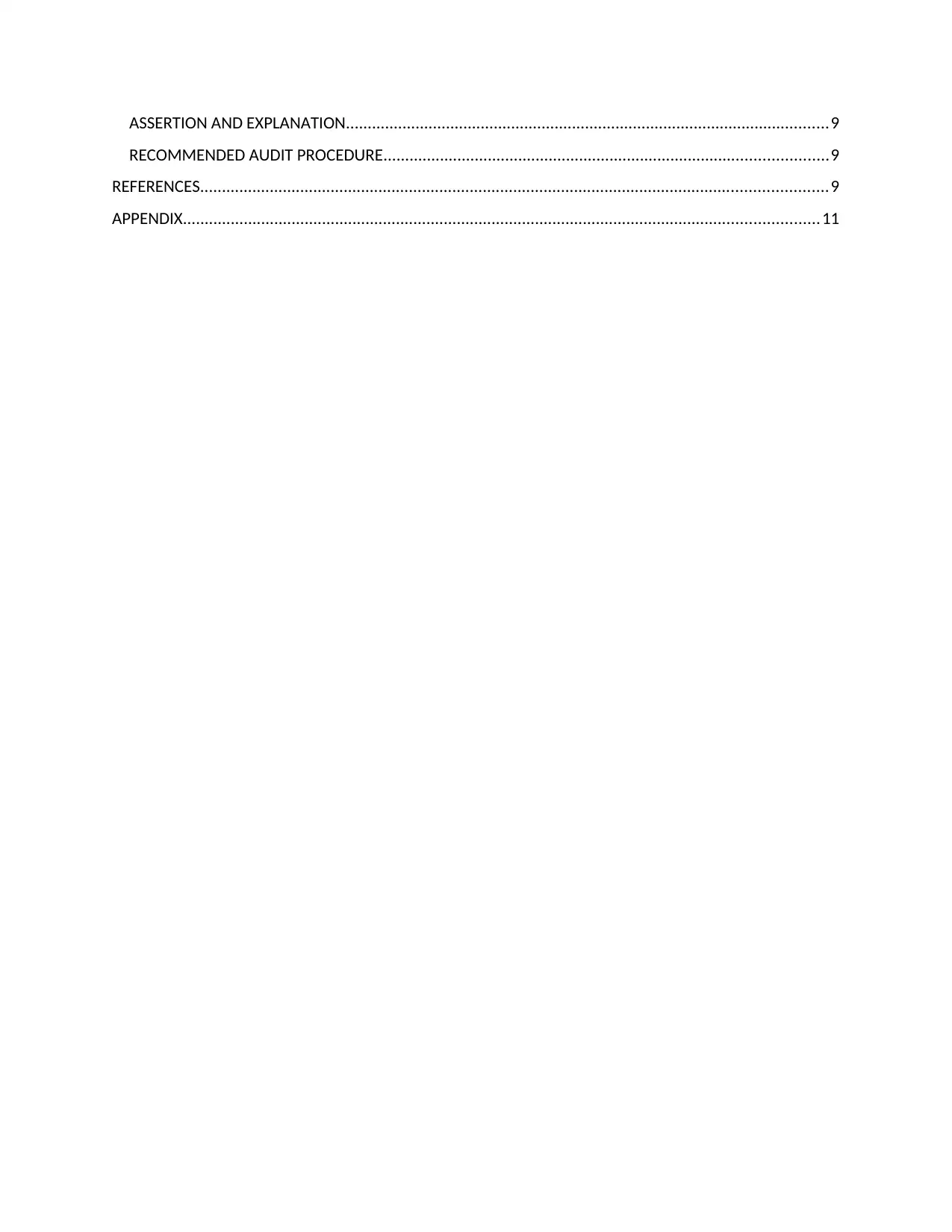
ASSERTION AND EXPLANATION...............................................................................................................9
RECOMMENDED AUDIT PROCEDURE......................................................................................................9
REFERENCES................................................................................................................................................9
APPENDIX..................................................................................................................................................11
RECOMMENDED AUDIT PROCEDURE......................................................................................................9
REFERENCES................................................................................................................................................9
APPENDIX..................................................................................................................................................11
⊘ This is a preview!⊘
Do you want full access?
Subscribe today to unlock all pages.

Trusted by 1+ million students worldwide
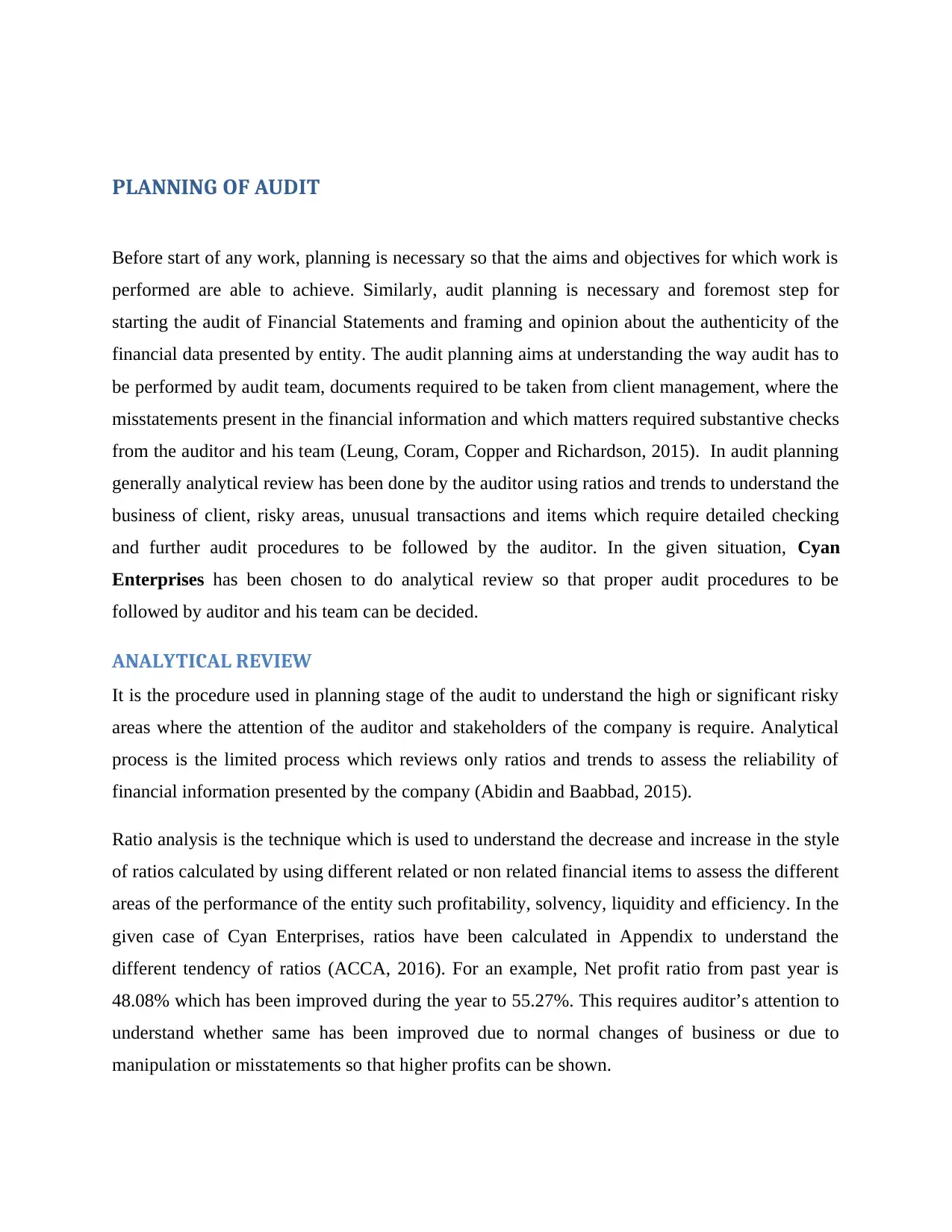
PLANNING OF AUDIT
Before start of any work, planning is necessary so that the aims and objectives for which work is
performed are able to achieve. Similarly, audit planning is necessary and foremost step for
starting the audit of Financial Statements and framing and opinion about the authenticity of the
financial data presented by entity. The audit planning aims at understanding the way audit has to
be performed by audit team, documents required to be taken from client management, where the
misstatements present in the financial information and which matters required substantive checks
from the auditor and his team (Leung, Coram, Copper and Richardson, 2015). In audit planning
generally analytical review has been done by the auditor using ratios and trends to understand the
business of client, risky areas, unusual transactions and items which require detailed checking
and further audit procedures to be followed by the auditor. In the given situation, Cyan
Enterprises has been chosen to do analytical review so that proper audit procedures to be
followed by auditor and his team can be decided.
ANALYTICAL REVIEW
It is the procedure used in planning stage of the audit to understand the high or significant risky
areas where the attention of the auditor and stakeholders of the company is require. Analytical
process is the limited process which reviews only ratios and trends to assess the reliability of
financial information presented by the company (Abidin and Baabbad, 2015).
Ratio analysis is the technique which is used to understand the decrease and increase in the style
of ratios calculated by using different related or non related financial items to assess the different
areas of the performance of the entity such profitability, solvency, liquidity and efficiency. In the
given case of Cyan Enterprises, ratios have been calculated in Appendix to understand the
different tendency of ratios (ACCA, 2016). For an example, Net profit ratio from past year is
48.08% which has been improved during the year to 55.27%. This requires auditor’s attention to
understand whether same has been improved due to normal changes of business or due to
manipulation or misstatements so that higher profits can be shown.
Before start of any work, planning is necessary so that the aims and objectives for which work is
performed are able to achieve. Similarly, audit planning is necessary and foremost step for
starting the audit of Financial Statements and framing and opinion about the authenticity of the
financial data presented by entity. The audit planning aims at understanding the way audit has to
be performed by audit team, documents required to be taken from client management, where the
misstatements present in the financial information and which matters required substantive checks
from the auditor and his team (Leung, Coram, Copper and Richardson, 2015). In audit planning
generally analytical review has been done by the auditor using ratios and trends to understand the
business of client, risky areas, unusual transactions and items which require detailed checking
and further audit procedures to be followed by the auditor. In the given situation, Cyan
Enterprises has been chosen to do analytical review so that proper audit procedures to be
followed by auditor and his team can be decided.
ANALYTICAL REVIEW
It is the procedure used in planning stage of the audit to understand the high or significant risky
areas where the attention of the auditor and stakeholders of the company is require. Analytical
process is the limited process which reviews only ratios and trends to assess the reliability of
financial information presented by the company (Abidin and Baabbad, 2015).
Ratio analysis is the technique which is used to understand the decrease and increase in the style
of ratios calculated by using different related or non related financial items to assess the different
areas of the performance of the entity such profitability, solvency, liquidity and efficiency. In the
given case of Cyan Enterprises, ratios have been calculated in Appendix to understand the
different tendency of ratios (ACCA, 2016). For an example, Net profit ratio from past year is
48.08% which has been improved during the year to 55.27%. This requires auditor’s attention to
understand whether same has been improved due to normal changes of business or due to
manipulation or misstatements so that higher profits can be shown.
Paraphrase This Document
Need a fresh take? Get an instant paraphrase of this document with our AI Paraphraser
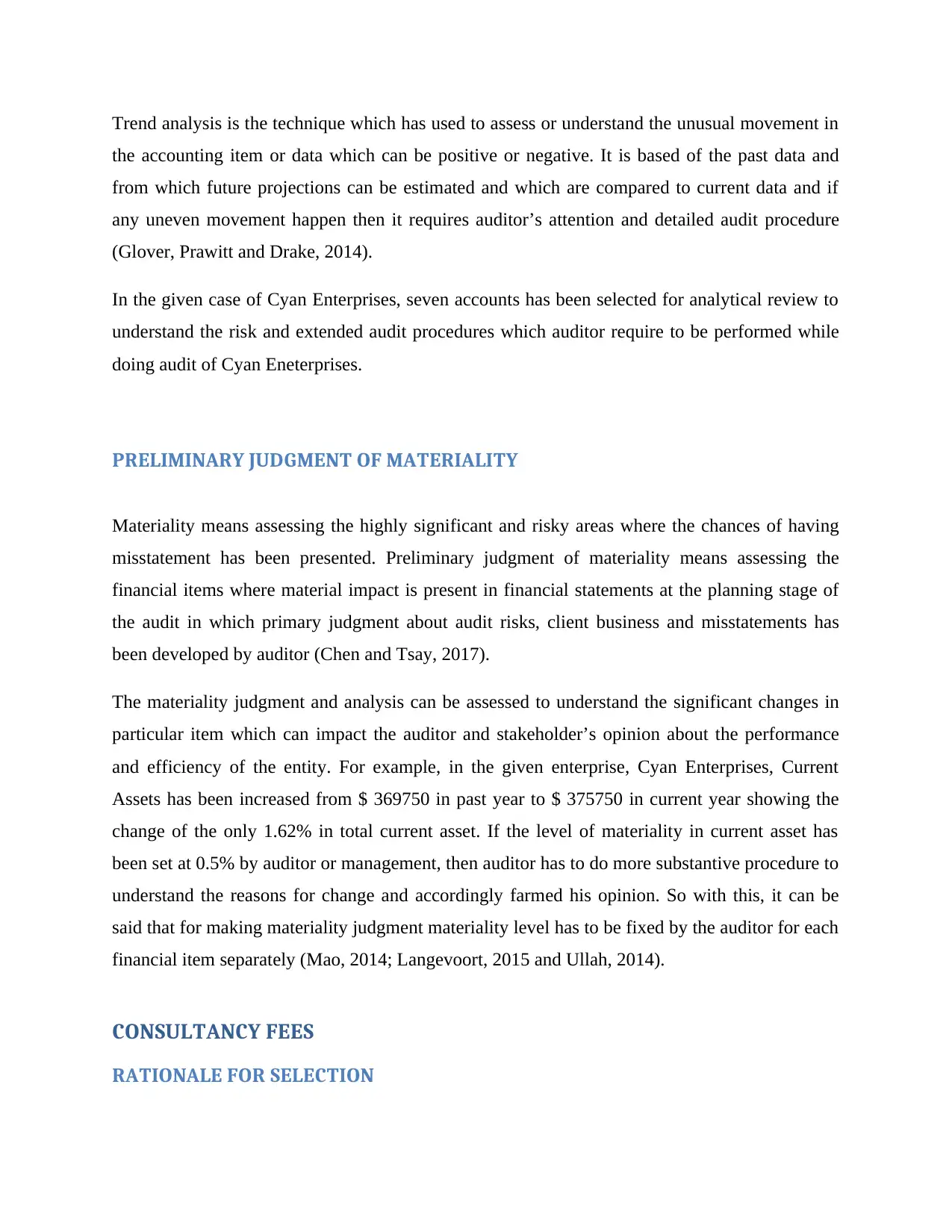
Trend analysis is the technique which has used to assess or understand the unusual movement in
the accounting item or data which can be positive or negative. It is based of the past data and
from which future projections can be estimated and which are compared to current data and if
any uneven movement happen then it requires auditor’s attention and detailed audit procedure
(Glover, Prawitt and Drake, 2014).
In the given case of Cyan Enterprises, seven accounts has been selected for analytical review to
understand the risk and extended audit procedures which auditor require to be performed while
doing audit of Cyan Eneterprises.
PRELIMINARY JUDGMENT OF MATERIALITY
Materiality means assessing the highly significant and risky areas where the chances of having
misstatement has been presented. Preliminary judgment of materiality means assessing the
financial items where material impact is present in financial statements at the planning stage of
the audit in which primary judgment about audit risks, client business and misstatements has
been developed by auditor (Chen and Tsay, 2017).
The materiality judgment and analysis can be assessed to understand the significant changes in
particular item which can impact the auditor and stakeholder’s opinion about the performance
and efficiency of the entity. For example, in the given enterprise, Cyan Enterprises, Current
Assets has been increased from $ 369750 in past year to $ 375750 in current year showing the
change of the only 1.62% in total current asset. If the level of materiality in current asset has
been set at 0.5% by auditor or management, then auditor has to do more substantive procedure to
understand the reasons for change and accordingly farmed his opinion. So with this, it can be
said that for making materiality judgment materiality level has to be fixed by the auditor for each
financial item separately (Mao, 2014; Langevoort, 2015 and Ullah, 2014).
CONSULTANCY FEES
RATIONALE FOR SELECTION
the accounting item or data which can be positive or negative. It is based of the past data and
from which future projections can be estimated and which are compared to current data and if
any uneven movement happen then it requires auditor’s attention and detailed audit procedure
(Glover, Prawitt and Drake, 2014).
In the given case of Cyan Enterprises, seven accounts has been selected for analytical review to
understand the risk and extended audit procedures which auditor require to be performed while
doing audit of Cyan Eneterprises.
PRELIMINARY JUDGMENT OF MATERIALITY
Materiality means assessing the highly significant and risky areas where the chances of having
misstatement has been presented. Preliminary judgment of materiality means assessing the
financial items where material impact is present in financial statements at the planning stage of
the audit in which primary judgment about audit risks, client business and misstatements has
been developed by auditor (Chen and Tsay, 2017).
The materiality judgment and analysis can be assessed to understand the significant changes in
particular item which can impact the auditor and stakeholder’s opinion about the performance
and efficiency of the entity. For example, in the given enterprise, Cyan Enterprises, Current
Assets has been increased from $ 369750 in past year to $ 375750 in current year showing the
change of the only 1.62% in total current asset. If the level of materiality in current asset has
been set at 0.5% by auditor or management, then auditor has to do more substantive procedure to
understand the reasons for change and accordingly farmed his opinion. So with this, it can be
said that for making materiality judgment materiality level has to be fixed by the auditor for each
financial item separately (Mao, 2014; Langevoort, 2015 and Ullah, 2014).
CONSULTANCY FEES
RATIONALE FOR SELECTION
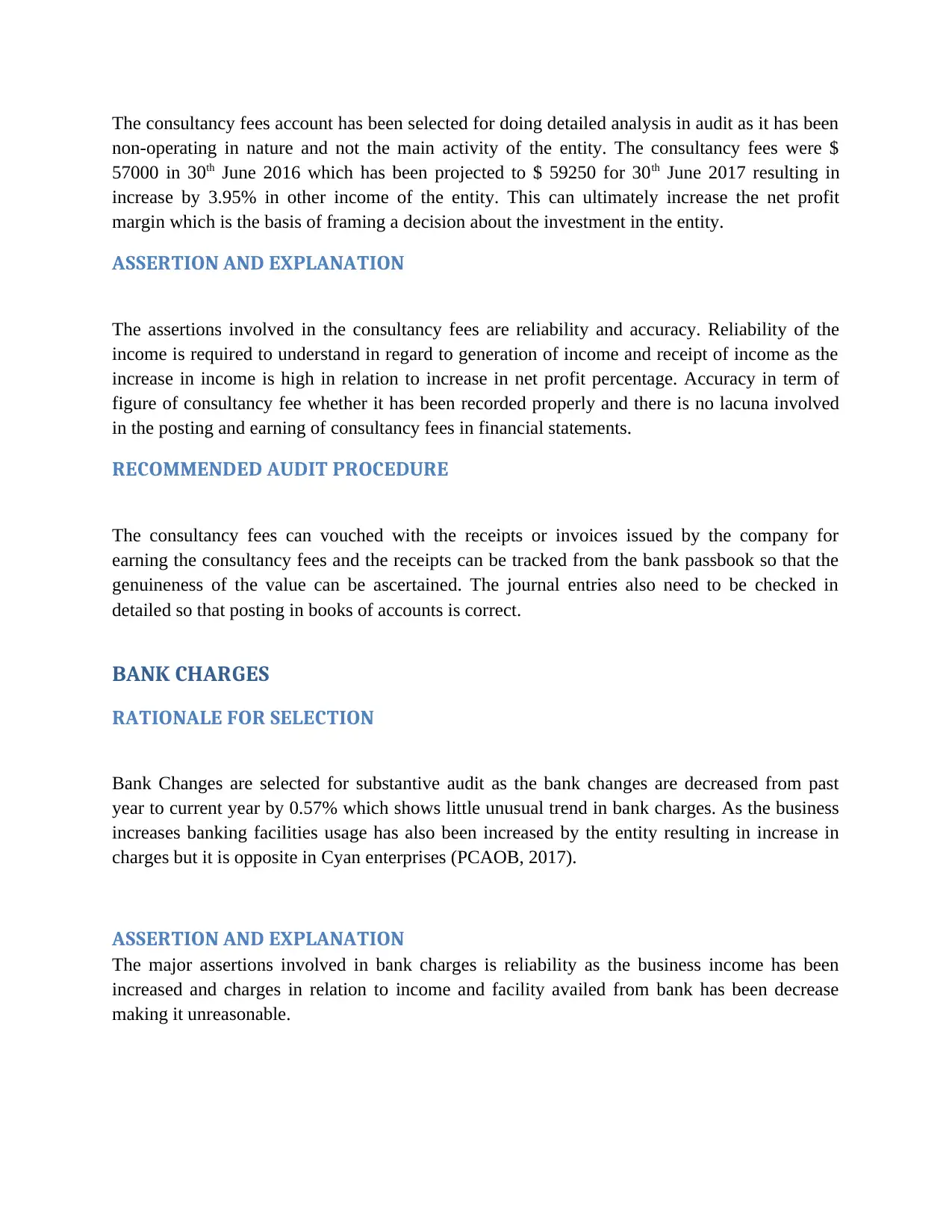
The consultancy fees account has been selected for doing detailed analysis in audit as it has been
non-operating in nature and not the main activity of the entity. The consultancy fees were $
57000 in 30th June 2016 which has been projected to $ 59250 for 30th June 2017 resulting in
increase by 3.95% in other income of the entity. This can ultimately increase the net profit
margin which is the basis of framing a decision about the investment in the entity.
ASSERTION AND EXPLANATION
The assertions involved in the consultancy fees are reliability and accuracy. Reliability of the
income is required to understand in regard to generation of income and receipt of income as the
increase in income is high in relation to increase in net profit percentage. Accuracy in term of
figure of consultancy fee whether it has been recorded properly and there is no lacuna involved
in the posting and earning of consultancy fees in financial statements.
RECOMMENDED AUDIT PROCEDURE
The consultancy fees can vouched with the receipts or invoices issued by the company for
earning the consultancy fees and the receipts can be tracked from the bank passbook so that the
genuineness of the value can be ascertained. The journal entries also need to be checked in
detailed so that posting in books of accounts is correct.
BANK CHARGES
RATIONALE FOR SELECTION
Bank Changes are selected for substantive audit as the bank changes are decreased from past
year to current year by 0.57% which shows little unusual trend in bank charges. As the business
increases banking facilities usage has also been increased by the entity resulting in increase in
charges but it is opposite in Cyan enterprises (PCAOB, 2017).
ASSERTION AND EXPLANATION
The major assertions involved in bank charges is reliability as the business income has been
increased and charges in relation to income and facility availed from bank has been decrease
making it unreasonable.
non-operating in nature and not the main activity of the entity. The consultancy fees were $
57000 in 30th June 2016 which has been projected to $ 59250 for 30th June 2017 resulting in
increase by 3.95% in other income of the entity. This can ultimately increase the net profit
margin which is the basis of framing a decision about the investment in the entity.
ASSERTION AND EXPLANATION
The assertions involved in the consultancy fees are reliability and accuracy. Reliability of the
income is required to understand in regard to generation of income and receipt of income as the
increase in income is high in relation to increase in net profit percentage. Accuracy in term of
figure of consultancy fee whether it has been recorded properly and there is no lacuna involved
in the posting and earning of consultancy fees in financial statements.
RECOMMENDED AUDIT PROCEDURE
The consultancy fees can vouched with the receipts or invoices issued by the company for
earning the consultancy fees and the receipts can be tracked from the bank passbook so that the
genuineness of the value can be ascertained. The journal entries also need to be checked in
detailed so that posting in books of accounts is correct.
BANK CHARGES
RATIONALE FOR SELECTION
Bank Changes are selected for substantive audit as the bank changes are decreased from past
year to current year by 0.57% which shows little unusual trend in bank charges. As the business
increases banking facilities usage has also been increased by the entity resulting in increase in
charges but it is opposite in Cyan enterprises (PCAOB, 2017).
ASSERTION AND EXPLANATION
The major assertions involved in bank charges is reliability as the business income has been
increased and charges in relation to income and facility availed from bank has been decrease
making it unreasonable.
⊘ This is a preview!⊘
Do you want full access?
Subscribe today to unlock all pages.

Trusted by 1+ million students worldwide
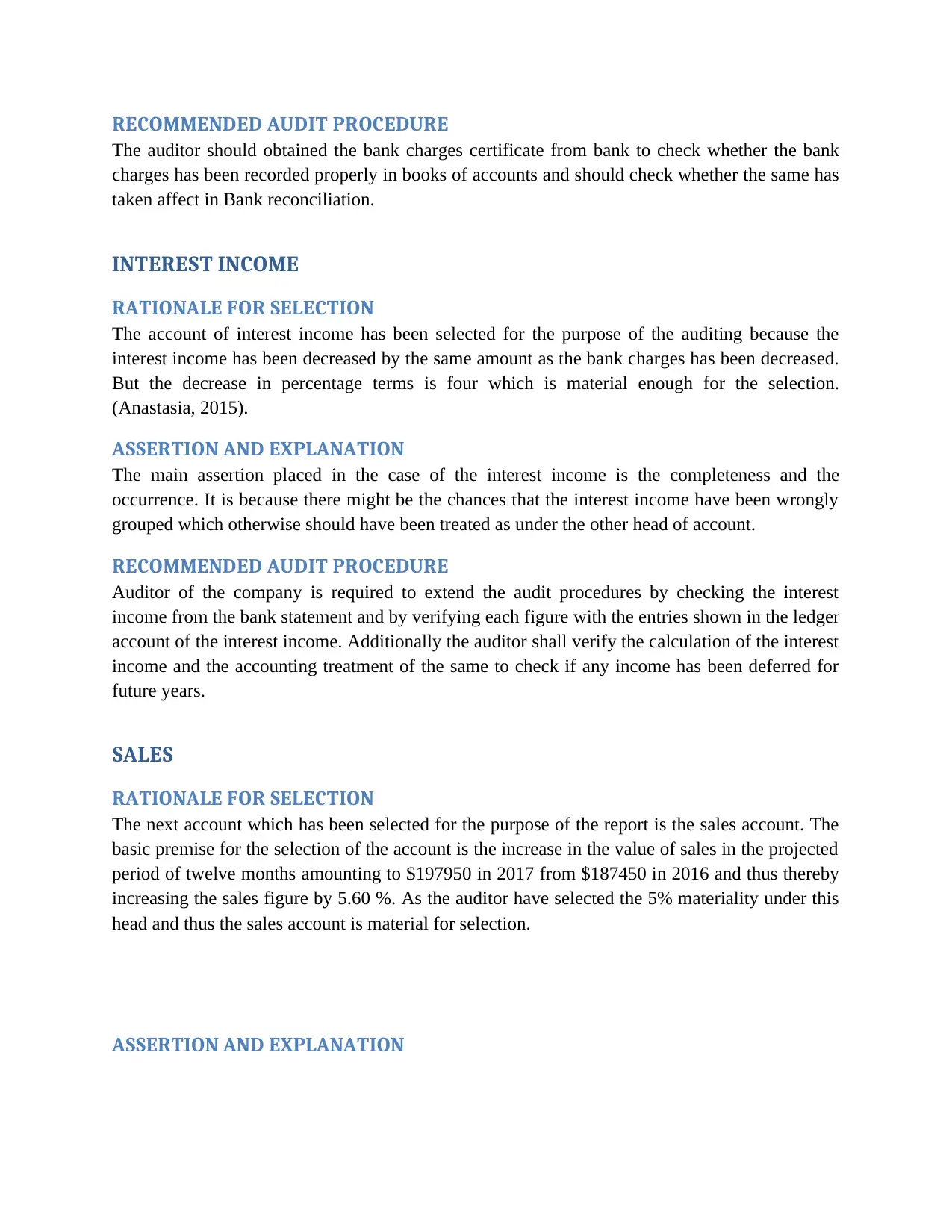
RECOMMENDED AUDIT PROCEDURE
The auditor should obtained the bank charges certificate from bank to check whether the bank
charges has been recorded properly in books of accounts and should check whether the same has
taken affect in Bank reconciliation.
INTEREST INCOME
RATIONALE FOR SELECTION
The account of interest income has been selected for the purpose of the auditing because the
interest income has been decreased by the same amount as the bank charges has been decreased.
But the decrease in percentage terms is four which is material enough for the selection.
(Anastasia, 2015).
ASSERTION AND EXPLANATION
The main assertion placed in the case of the interest income is the completeness and the
occurrence. It is because there might be the chances that the interest income have been wrongly
grouped which otherwise should have been treated as under the other head of account.
RECOMMENDED AUDIT PROCEDURE
Auditor of the company is required to extend the audit procedures by checking the interest
income from the bank statement and by verifying each figure with the entries shown in the ledger
account of the interest income. Additionally the auditor shall verify the calculation of the interest
income and the accounting treatment of the same to check if any income has been deferred for
future years.
SALES
RATIONALE FOR SELECTION
The next account which has been selected for the purpose of the report is the sales account. The
basic premise for the selection of the account is the increase in the value of sales in the projected
period of twelve months amounting to $197950 in 2017 from $187450 in 2016 and thus thereby
increasing the sales figure by 5.60 %. As the auditor have selected the 5% materiality under this
head and thus the sales account is material for selection.
ASSERTION AND EXPLANATION
The auditor should obtained the bank charges certificate from bank to check whether the bank
charges has been recorded properly in books of accounts and should check whether the same has
taken affect in Bank reconciliation.
INTEREST INCOME
RATIONALE FOR SELECTION
The account of interest income has been selected for the purpose of the auditing because the
interest income has been decreased by the same amount as the bank charges has been decreased.
But the decrease in percentage terms is four which is material enough for the selection.
(Anastasia, 2015).
ASSERTION AND EXPLANATION
The main assertion placed in the case of the interest income is the completeness and the
occurrence. It is because there might be the chances that the interest income have been wrongly
grouped which otherwise should have been treated as under the other head of account.
RECOMMENDED AUDIT PROCEDURE
Auditor of the company is required to extend the audit procedures by checking the interest
income from the bank statement and by verifying each figure with the entries shown in the ledger
account of the interest income. Additionally the auditor shall verify the calculation of the interest
income and the accounting treatment of the same to check if any income has been deferred for
future years.
SALES
RATIONALE FOR SELECTION
The next account which has been selected for the purpose of the report is the sales account. The
basic premise for the selection of the account is the increase in the value of sales in the projected
period of twelve months amounting to $197950 in 2017 from $187450 in 2016 and thus thereby
increasing the sales figure by 5.60 %. As the auditor have selected the 5% materiality under this
head and thus the sales account is material for selection.
ASSERTION AND EXPLANATION
Paraphrase This Document
Need a fresh take? Get an instant paraphrase of this document with our AI Paraphraser
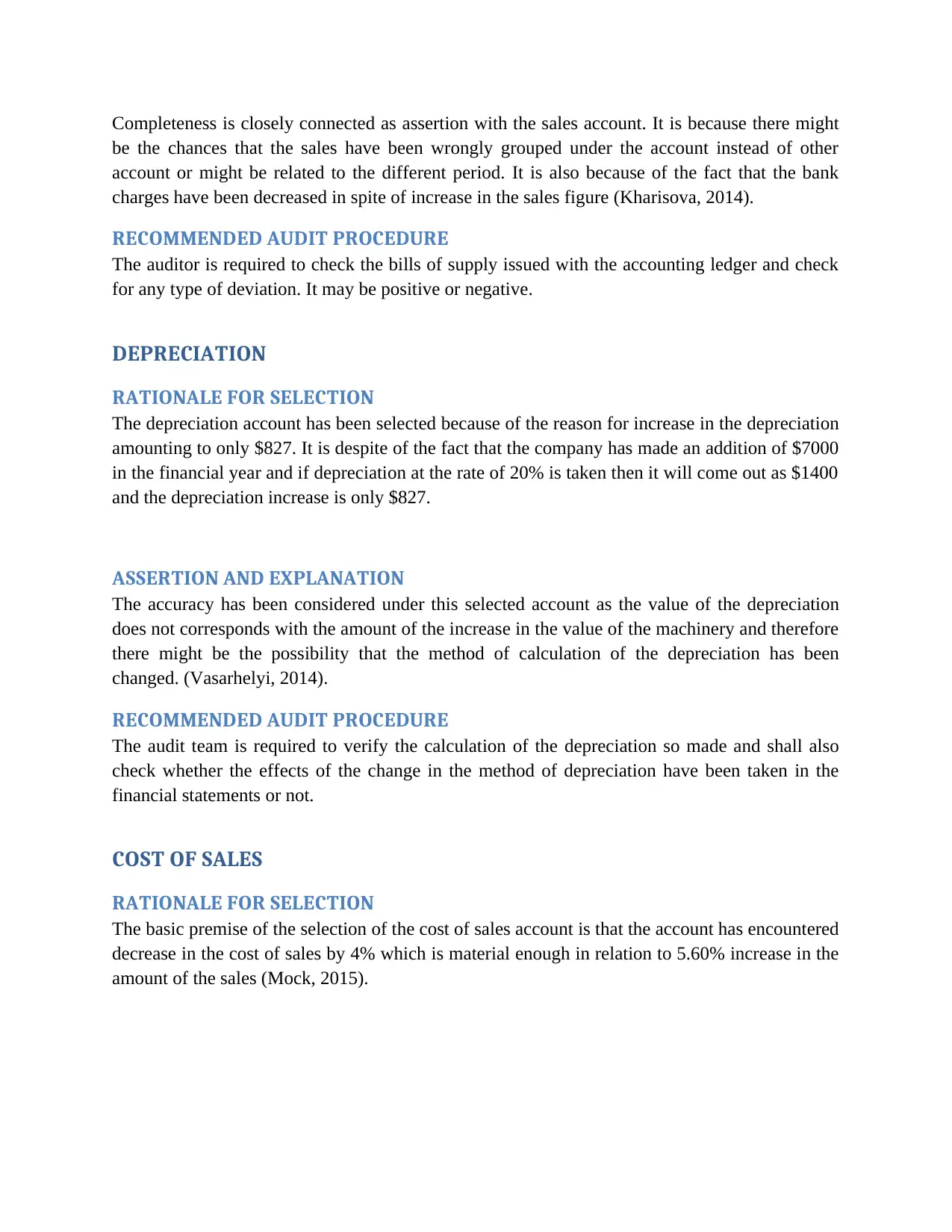
Completeness is closely connected as assertion with the sales account. It is because there might
be the chances that the sales have been wrongly grouped under the account instead of other
account or might be related to the different period. It is also because of the fact that the bank
charges have been decreased in spite of increase in the sales figure (Kharisova, 2014).
RECOMMENDED AUDIT PROCEDURE
The auditor is required to check the bills of supply issued with the accounting ledger and check
for any type of deviation. It may be positive or negative.
DEPRECIATION
RATIONALE FOR SELECTION
The depreciation account has been selected because of the reason for increase in the depreciation
amounting to only $827. It is despite of the fact that the company has made an addition of $7000
in the financial year and if depreciation at the rate of 20% is taken then it will come out as $1400
and the depreciation increase is only $827.
ASSERTION AND EXPLANATION
The accuracy has been considered under this selected account as the value of the depreciation
does not corresponds with the amount of the increase in the value of the machinery and therefore
there might be the possibility that the method of calculation of the depreciation has been
changed. (Vasarhelyi, 2014).
RECOMMENDED AUDIT PROCEDURE
The audit team is required to verify the calculation of the depreciation so made and shall also
check whether the effects of the change in the method of depreciation have been taken in the
financial statements or not.
COST OF SALES
RATIONALE FOR SELECTION
The basic premise of the selection of the cost of sales account is that the account has encountered
decrease in the cost of sales by 4% which is material enough in relation to 5.60% increase in the
amount of the sales (Mock, 2015).
be the chances that the sales have been wrongly grouped under the account instead of other
account or might be related to the different period. It is also because of the fact that the bank
charges have been decreased in spite of increase in the sales figure (Kharisova, 2014).
RECOMMENDED AUDIT PROCEDURE
The auditor is required to check the bills of supply issued with the accounting ledger and check
for any type of deviation. It may be positive or negative.
DEPRECIATION
RATIONALE FOR SELECTION
The depreciation account has been selected because of the reason for increase in the depreciation
amounting to only $827. It is despite of the fact that the company has made an addition of $7000
in the financial year and if depreciation at the rate of 20% is taken then it will come out as $1400
and the depreciation increase is only $827.
ASSERTION AND EXPLANATION
The accuracy has been considered under this selected account as the value of the depreciation
does not corresponds with the amount of the increase in the value of the machinery and therefore
there might be the possibility that the method of calculation of the depreciation has been
changed. (Vasarhelyi, 2014).
RECOMMENDED AUDIT PROCEDURE
The audit team is required to verify the calculation of the depreciation so made and shall also
check whether the effects of the change in the method of depreciation have been taken in the
financial statements or not.
COST OF SALES
RATIONALE FOR SELECTION
The basic premise of the selection of the cost of sales account is that the account has encountered
decrease in the cost of sales by 4% which is material enough in relation to 5.60% increase in the
amount of the sales (Mock, 2015).
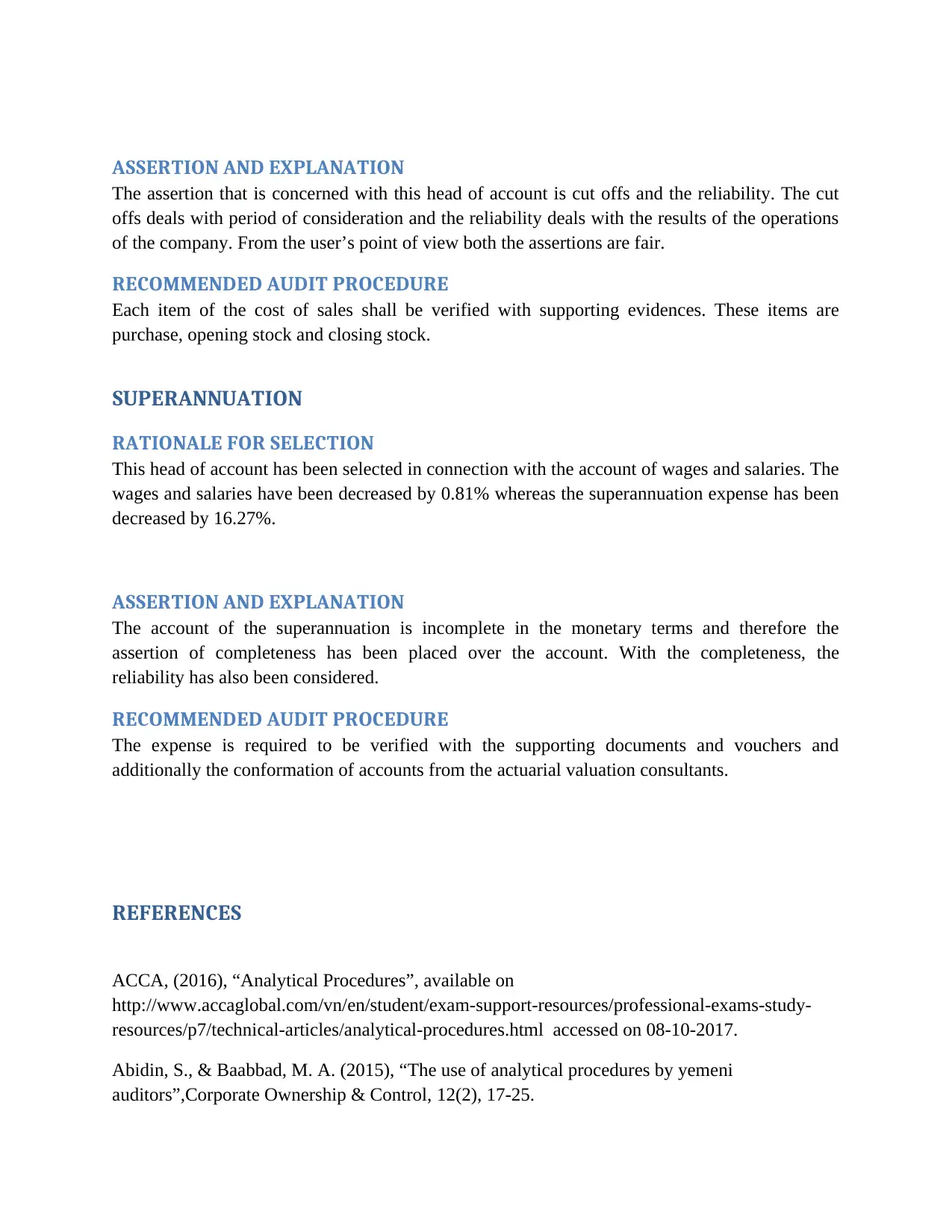
ASSERTION AND EXPLANATION
The assertion that is concerned with this head of account is cut offs and the reliability. The cut
offs deals with period of consideration and the reliability deals with the results of the operations
of the company. From the user’s point of view both the assertions are fair.
RECOMMENDED AUDIT PROCEDURE
Each item of the cost of sales shall be verified with supporting evidences. These items are
purchase, opening stock and closing stock.
SUPERANNUATION
RATIONALE FOR SELECTION
This head of account has been selected in connection with the account of wages and salaries. The
wages and salaries have been decreased by 0.81% whereas the superannuation expense has been
decreased by 16.27%.
ASSERTION AND EXPLANATION
The account of the superannuation is incomplete in the monetary terms and therefore the
assertion of completeness has been placed over the account. With the completeness, the
reliability has also been considered.
RECOMMENDED AUDIT PROCEDURE
The expense is required to be verified with the supporting documents and vouchers and
additionally the conformation of accounts from the actuarial valuation consultants.
REFERENCES
ACCA, (2016), “Analytical Procedures”, available on
http://www.accaglobal.com/vn/en/student/exam-support-resources/professional-exams-study-
resources/p7/technical-articles/analytical-procedures.html accessed on 08-10-2017.
Abidin, S., & Baabbad, M. A. (2015), “The use of analytical procedures by yemeni
auditors”,Corporate Ownership & Control, 12(2), 17-25.
The assertion that is concerned with this head of account is cut offs and the reliability. The cut
offs deals with period of consideration and the reliability deals with the results of the operations
of the company. From the user’s point of view both the assertions are fair.
RECOMMENDED AUDIT PROCEDURE
Each item of the cost of sales shall be verified with supporting evidences. These items are
purchase, opening stock and closing stock.
SUPERANNUATION
RATIONALE FOR SELECTION
This head of account has been selected in connection with the account of wages and salaries. The
wages and salaries have been decreased by 0.81% whereas the superannuation expense has been
decreased by 16.27%.
ASSERTION AND EXPLANATION
The account of the superannuation is incomplete in the monetary terms and therefore the
assertion of completeness has been placed over the account. With the completeness, the
reliability has also been considered.
RECOMMENDED AUDIT PROCEDURE
The expense is required to be verified with the supporting documents and vouchers and
additionally the conformation of accounts from the actuarial valuation consultants.
REFERENCES
ACCA, (2016), “Analytical Procedures”, available on
http://www.accaglobal.com/vn/en/student/exam-support-resources/professional-exams-study-
resources/p7/technical-articles/analytical-procedures.html accessed on 08-10-2017.
Abidin, S., & Baabbad, M. A. (2015), “The use of analytical procedures by yemeni
auditors”,Corporate Ownership & Control, 12(2), 17-25.
⊘ This is a preview!⊘
Do you want full access?
Subscribe today to unlock all pages.

Trusted by 1+ million students worldwide
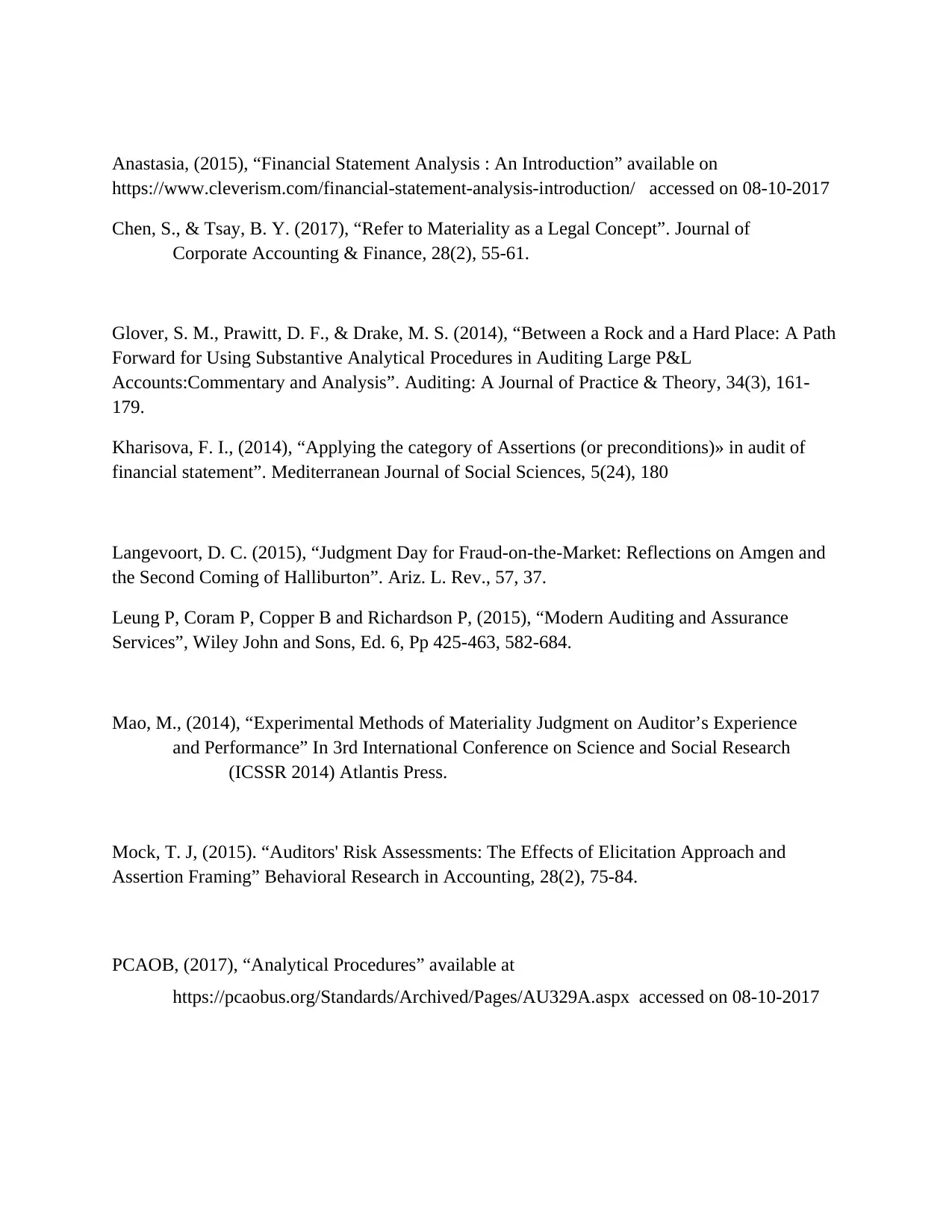
Anastasia, (2015), “Financial Statement Analysis : An Introduction” available on
https://www.cleverism.com/financial-statement-analysis-introduction/ accessed on 08-10-2017
Chen, S., & Tsay, B. Y. (2017), “Refer to Materiality as a Legal Concept”. Journal of
Corporate Accounting & Finance, 28(2), 55-61.
Glover, S. M., Prawitt, D. F., & Drake, M. S. (2014), “Between a Rock and a Hard Place: A Path
Forward for Using Substantive Analytical Procedures in Auditing Large P&L
Accounts:Commentary and Analysis”. Auditing: A Journal of Practice & Theory, 34(3), 161-
179.
Kharisova, F. I., (2014), “Applying the category of Assertions (or preconditions)» in audit of
financial statement”. Mediterranean Journal of Social Sciences, 5(24), 180
Langevoort, D. C. (2015), “Judgment Day for Fraud-on-the-Market: Reflections on Amgen and
the Second Coming of Halliburton”. Ariz. L. Rev., 57, 37.
Leung P, Coram P, Copper B and Richardson P, (2015), “Modern Auditing and Assurance
Services”, Wiley John and Sons, Ed. 6, Pp 425-463, 582-684.
Mao, M., (2014), “Experimental Methods of Materiality Judgment on Auditor’s Experience
and Performance” In 3rd International Conference on Science and Social Research
(ICSSR 2014) Atlantis Press.
Mock, T. J, (2015). “Auditors' Risk Assessments: The Effects of Elicitation Approach and
Assertion Framing” Behavioral Research in Accounting, 28(2), 75-84.
PCAOB, (2017), “Analytical Procedures” available at
https://pcaobus.org/Standards/Archived/Pages/AU329A.aspx accessed on 08-10-2017
https://www.cleverism.com/financial-statement-analysis-introduction/ accessed on 08-10-2017
Chen, S., & Tsay, B. Y. (2017), “Refer to Materiality as a Legal Concept”. Journal of
Corporate Accounting & Finance, 28(2), 55-61.
Glover, S. M., Prawitt, D. F., & Drake, M. S. (2014), “Between a Rock and a Hard Place: A Path
Forward for Using Substantive Analytical Procedures in Auditing Large P&L
Accounts:Commentary and Analysis”. Auditing: A Journal of Practice & Theory, 34(3), 161-
179.
Kharisova, F. I., (2014), “Applying the category of Assertions (or preconditions)» in audit of
financial statement”. Mediterranean Journal of Social Sciences, 5(24), 180
Langevoort, D. C. (2015), “Judgment Day for Fraud-on-the-Market: Reflections on Amgen and
the Second Coming of Halliburton”. Ariz. L. Rev., 57, 37.
Leung P, Coram P, Copper B and Richardson P, (2015), “Modern Auditing and Assurance
Services”, Wiley John and Sons, Ed. 6, Pp 425-463, 582-684.
Mao, M., (2014), “Experimental Methods of Materiality Judgment on Auditor’s Experience
and Performance” In 3rd International Conference on Science and Social Research
(ICSSR 2014) Atlantis Press.
Mock, T. J, (2015). “Auditors' Risk Assessments: The Effects of Elicitation Approach and
Assertion Framing” Behavioral Research in Accounting, 28(2), 75-84.
PCAOB, (2017), “Analytical Procedures” available at
https://pcaobus.org/Standards/Archived/Pages/AU329A.aspx accessed on 08-10-2017
Paraphrase This Document
Need a fresh take? Get an instant paraphrase of this document with our AI Paraphraser
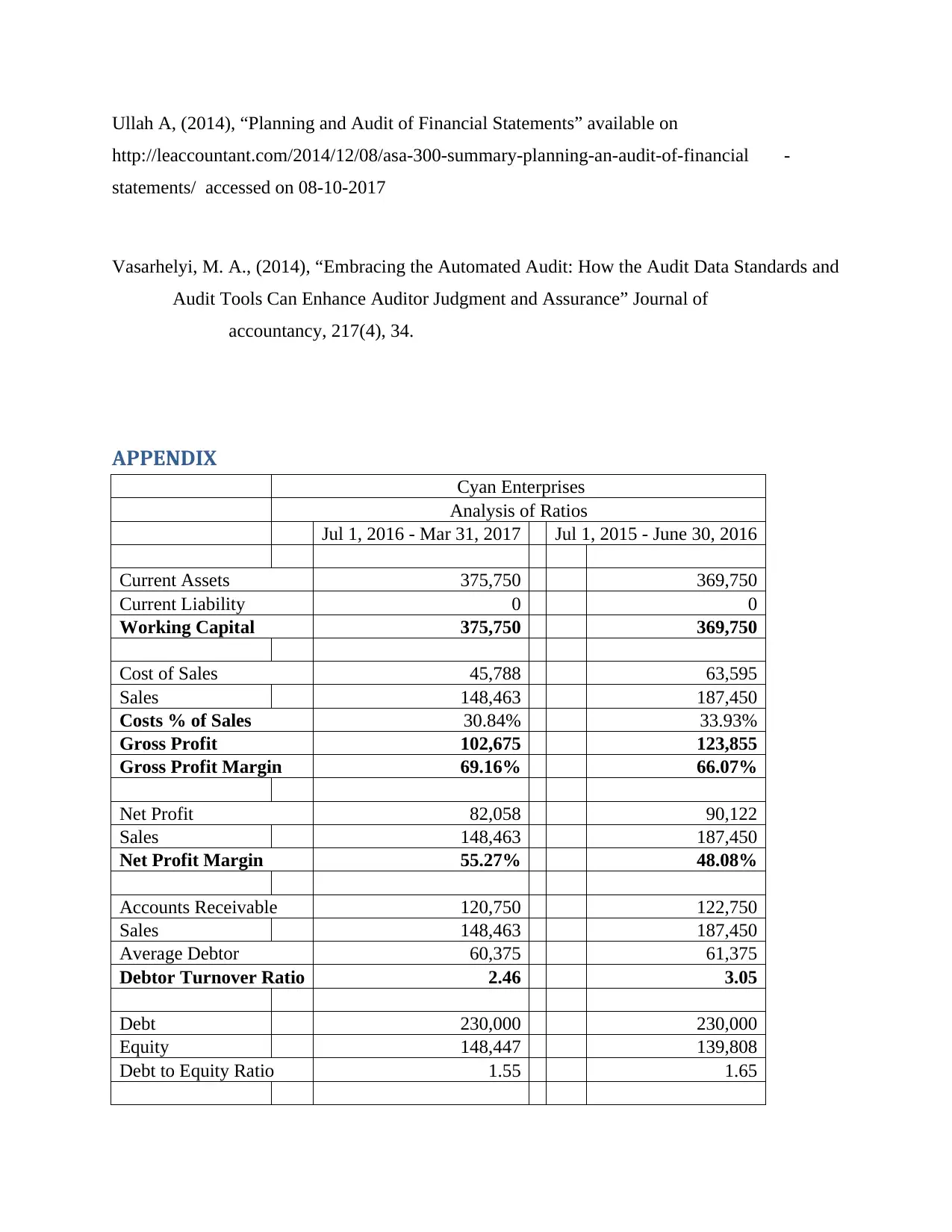
Ullah A, (2014), “Planning and Audit of Financial Statements” available on
http://leaccountant.com/2014/12/08/asa-300-summary-planning-an-audit-of-financial -
statements/ accessed on 08-10-2017
Vasarhelyi, M. A., (2014), “Embracing the Automated Audit: How the Audit Data Standards and
Audit Tools Can Enhance Auditor Judgment and Assurance” Journal of
accountancy, 217(4), 34.
APPENDIX
Cyan Enterprises
Analysis of Ratios
Jul 1, 2016 - Mar 31, 2017 Jul 1, 2015 - June 30, 2016
Current Assets 375,750 369,750
Current Liability 0 0
Working Capital 375,750 369,750
Cost of Sales 45,788 63,595
Sales 148,463 187,450
Costs % of Sales 30.84% 33.93%
Gross Profit 102,675 123,855
Gross Profit Margin 69.16% 66.07%
Net Profit 82,058 90,122
Sales 148,463 187,450
Net Profit Margin 55.27% 48.08%
Accounts Receivable 120,750 122,750
Sales 148,463 187,450
Average Debtor 60,375 61,375
Debtor Turnover Ratio 2.46 3.05
Debt 230,000 230,000
Equity 148,447 139,808
Debt to Equity Ratio 1.55 1.65
http://leaccountant.com/2014/12/08/asa-300-summary-planning-an-audit-of-financial -
statements/ accessed on 08-10-2017
Vasarhelyi, M. A., (2014), “Embracing the Automated Audit: How the Audit Data Standards and
Audit Tools Can Enhance Auditor Judgment and Assurance” Journal of
accountancy, 217(4), 34.
APPENDIX
Cyan Enterprises
Analysis of Ratios
Jul 1, 2016 - Mar 31, 2017 Jul 1, 2015 - June 30, 2016
Current Assets 375,750 369,750
Current Liability 0 0
Working Capital 375,750 369,750
Cost of Sales 45,788 63,595
Sales 148,463 187,450
Costs % of Sales 30.84% 33.93%
Gross Profit 102,675 123,855
Gross Profit Margin 69.16% 66.07%
Net Profit 82,058 90,122
Sales 148,463 187,450
Net Profit Margin 55.27% 48.08%
Accounts Receivable 120,750 122,750
Sales 148,463 187,450
Average Debtor 60,375 61,375
Debtor Turnover Ratio 2.46 3.05
Debt 230,000 230,000
Equity 148,447 139,808
Debt to Equity Ratio 1.55 1.65
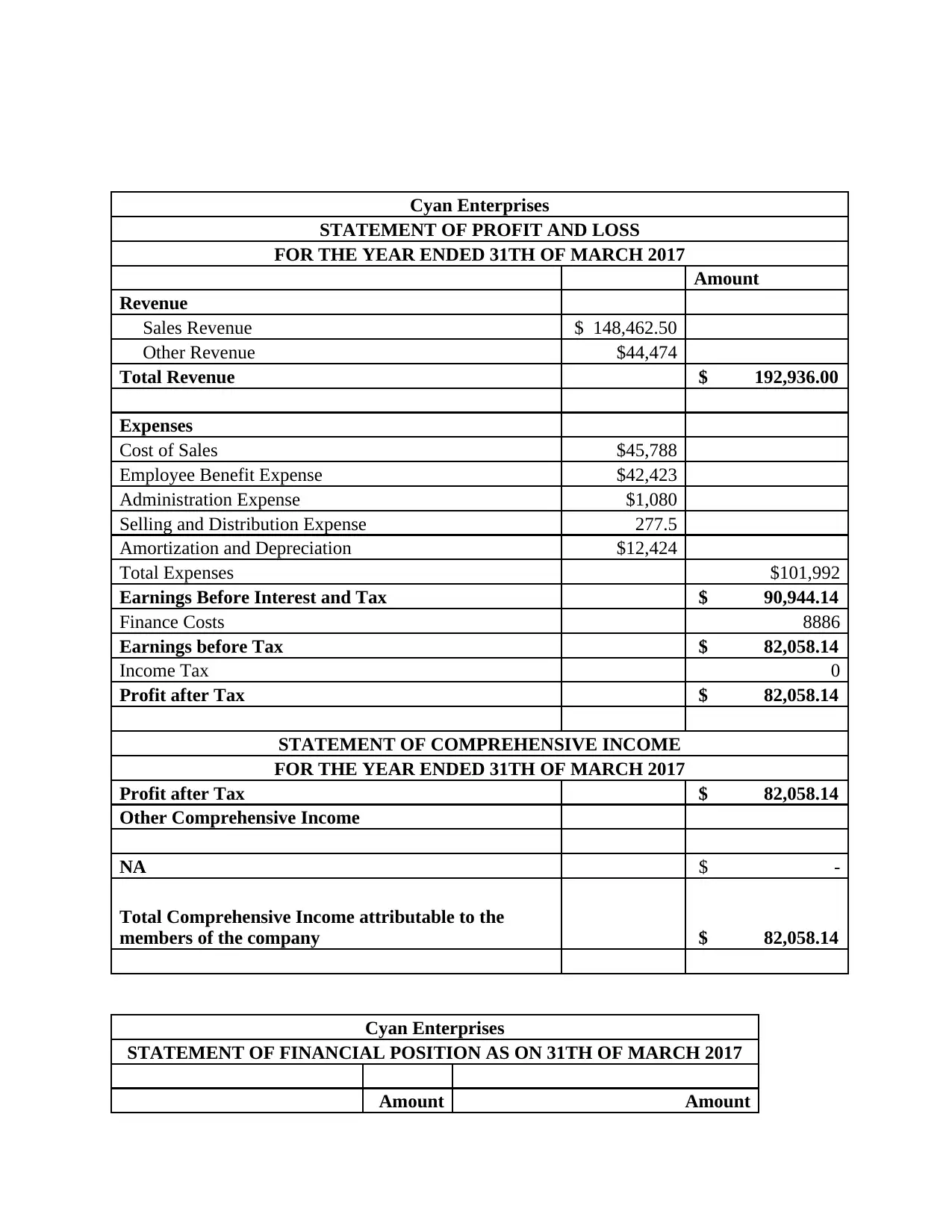
Cyan Enterprises
STATEMENT OF PROFIT AND LOSS
FOR THE YEAR ENDED 31TH OF MARCH 2017
Amount
Revenue
Sales Revenue $ 148,462.50
Other Revenue $44,474
Total Revenue $ 192,936.00
Expenses
Cost of Sales $45,788
Employee Benefit Expense $42,423
Administration Expense $1,080
Selling and Distribution Expense 277.5
Amortization and Depreciation $12,424
Total Expenses $101,992
Earnings Before Interest and Tax $ 90,944.14
Finance Costs 8886
Earnings before Tax $ 82,058.14
Income Tax 0
Profit after Tax $ 82,058.14
STATEMENT OF COMPREHENSIVE INCOME
FOR THE YEAR ENDED 31TH OF MARCH 2017
Profit after Tax $ 82,058.14
Other Comprehensive Income
NA $ -
Total Comprehensive Income attributable to the
members of the company $ 82,058.14
Cyan Enterprises
STATEMENT OF FINANCIAL POSITION AS ON 31TH OF MARCH 2017
Amount Amount
STATEMENT OF PROFIT AND LOSS
FOR THE YEAR ENDED 31TH OF MARCH 2017
Amount
Revenue
Sales Revenue $ 148,462.50
Other Revenue $44,474
Total Revenue $ 192,936.00
Expenses
Cost of Sales $45,788
Employee Benefit Expense $42,423
Administration Expense $1,080
Selling and Distribution Expense 277.5
Amortization and Depreciation $12,424
Total Expenses $101,992
Earnings Before Interest and Tax $ 90,944.14
Finance Costs 8886
Earnings before Tax $ 82,058.14
Income Tax 0
Profit after Tax $ 82,058.14
STATEMENT OF COMPREHENSIVE INCOME
FOR THE YEAR ENDED 31TH OF MARCH 2017
Profit after Tax $ 82,058.14
Other Comprehensive Income
NA $ -
Total Comprehensive Income attributable to the
members of the company $ 82,058.14
Cyan Enterprises
STATEMENT OF FINANCIAL POSITION AS ON 31TH OF MARCH 2017
Amount Amount
⊘ This is a preview!⊘
Do you want full access?
Subscribe today to unlock all pages.

Trusted by 1+ million students worldwide
1 out of 16
Related Documents
Your All-in-One AI-Powered Toolkit for Academic Success.
+13062052269
info@desklib.com
Available 24*7 on WhatsApp / Email
![[object Object]](/_next/static/media/star-bottom.7253800d.svg)
Unlock your academic potential
Copyright © 2020–2025 A2Z Services. All Rights Reserved. Developed and managed by ZUCOL.





